Evaluation of Ecological Sustainability Criteria of Urban Green Spaces in Adelaide Metropolitan Area
Abstract
1. Introduction
- To identify the ecological sustainability criteria most relevant to effective UGS planning;
- To evaluate the current status of UGS in the case study suburbs based on these criteria;
- To compare the selected suburbs to determine spatial differences in ecological sustainability performance;
- To determine which criteria most significantly influence ecological sustainability in the context of Adelaide;
- To develop guidelines and policies to improve the challenging criteria to promote ecological sustainability.
- -
- Which UGS planning criteria are more effective for urban ecological sustainability?
- -
- What is the status of UGS in the case study in terms of affecting ecological sustainability criteria?
- -
- What are the differences between the studied suburbs regarding ecological criteria?
- -
- Which criteria have more impact on the urban ecological sustainability?
- -
- What solutions are required to improve the challenging criteria?
2. Methodology
2.1. Content Analysis
2.2. Household Survey
2.3. Local Experts’ Interview
3. Results
3.1. Ecological Sustainability Criteria for UGS Planning
3.1.1. Main Affecting Domains
3.1.2. Most Critical Ecological Sustainability Criteria
3.2. Evaluation of the Critical Criteria for Ecological Sustainability
3.2.1. General Characteristics of the Respondents
3.2.2. Descriptive Analysis of Ecological Criteria in the Case Studies
3.2.3. Evaluating Ecological Sustainability Criteria in the Case Studies
3.2.4. Investigating the Impact of UGS Planning Criteria on Urban Ecological Sustainability
3.2.5. Analysing the Spatial Impacts of UGS Planning Criteria on Ecological Sustainability by GWR
3.3. Experts Interview
4. Discussion
- Supporting data-driven, context-specific planning and design of green spaces;
- Informing local governments on where to prioritise ecological improvements in UGS;
- Enhancing community resilience through more sustainable urban ecosystems.
5. Conclusions
Author Contributions
Funding
Institutional Review Board Statement
Informed Consent Statement
Data Availability Statement
Conflicts of Interest
References
- Arshad, S.; Ahmad, S.R.; Abbas, S.; Asharf, A.; Siddiqui, N.A.; ul Islam, Z. Quantifying the contribution of diminishing green spaces and urban sprawl to urban heat island effect in a rapidly urbanizing metropolitan city of Pakistan. Land Use Policy 2022, 113, 105874. [Google Scholar] [CrossRef]
- García-Ayllón, S. Rapid development as a factor of imbalance in urban growth of cities in Latin America: A perspective based on territorial indicators. Habitat Int. 2016, 58, 127–142. [Google Scholar] [CrossRef]
- Haas, J.; Ban, Y. Urban growth and environmental impacts in jing-jin-ji, the yangtze, river delta and the pearl river delta. Int. J. Appl. Earth Obs. Geoinf. 2014, 30, 42–55. [Google Scholar] [CrossRef]
- Zenouzi, A.S.; Yenneti, K.; Teimouri, R.; Abbasiyan, F.; Palme, M. Analysis of changes in vegetation index during the rapid urban spatial development period (1990–2020) in Tehran metropolis, Iran. Atmosphere 2022, 13, 2010. [Google Scholar] [CrossRef]
- Dinda, S.; Chatterjee, N.D.; Ghosh, S. An integrated simulation approach to the assessment of urban growth pattern and loss in urban green space in Kolkata, India: A GIS-based analysis. Ecol. Indic. 2021, 121, 107178. [Google Scholar] [CrossRef]
- Olad Ghaffari, P.; Monavari, S.M. Physical development trend and green space destruction in developing cities: A GIS approach. Environ. Dev. Sustain. 2013, 15, 167–175. [Google Scholar] [CrossRef]
- Trinder, J.; Liu, Q. Assessing environmental impacts of urban growth using remote sensing. Geo-Spat. Inf. Sci. 2020, 23, 20–39. [Google Scholar] [CrossRef]
- Feng, L.; Mi, X.; Yuan, D. Optimal planning of urban greening system in response to urban microenvironments in a high-density city using genetic algorithm: A case study of Tianjin. Sustain. Cities Soc. 2022, 87, 104244. [Google Scholar] [CrossRef]
- Maheng, D.; Ducton, I.; Lauwaet, D.; Zevenbergen, C.; Pathirana, A. The Sensitivity of Urban Heat Island to Urban Green Space—A Model-Based Study of City of Colombo, Sri Lanka. Atmosphere 2019, 10, 151. [Google Scholar] [CrossRef]
- Mukherjee, M.; Takara, K. Urban green space as a countermeasure to increasing urban risk and the UGS-3CC resilience framework. Int. J. Disaster Risk Reduct. 2018, 28, 854–861. [Google Scholar] [CrossRef]
- Wang, X.; Meng, Q.; Zhang, L.; Hu, D. Evaluation of urban green space in terms of thermal environmental benefits using geographical detector analysis. Int. J. Appl. Earth Obs. Geoinf. 2021, 105, 102610. [Google Scholar] [CrossRef]
- Yoong, H.Q.; Lim, K.Y.; Lee, L.K.; Zakaria, N.A.; Foo, K.Y. Sustainable urban green space management practice. In Proceedings of the International Malaysia-Indonesia-Thailand Symposium on Innovation and Creativity (iMIT-SIC), Arau, Malaysia, 26–27 July 2017; pp. 1–4. [Google Scholar]
- Peng, J.; Wang, Y.; Wu, J.; Shen, H.; Pan, Y. Research progress on evaluation frameworks of regional ecological sustainability. Chin. Geogr. Sci. 2011, 21, 496–510. [Google Scholar] [CrossRef]
- Van Oijstaeijen, W.; Van Passel, S.; Cools, J. Urban green infrastructure: A review on valuation toolkits from an urban planning perspective. J. Environ. Manag. 2020, 267, 110603. [Google Scholar] [CrossRef]
- Aronson, M.F.; Lepczyk, C.A.; Evans, K.L.; Goddard, M.A.; Lerman, S.B.; MacIvor, J.S.; Nilon, C.H.; Vargo, T. Biodiversity in the city: Key challenges for urban green space management. Front. Ecol. Environ. 2017, 15, 189–196. [Google Scholar] [CrossRef]
- Tian, Y.; Jim, C.Y.; Wang, H. Assessing the landscape and ecological quality of urban green spaces in a compact city. Landsc. Urban Plan. 2014, 121, 97–108. [Google Scholar] [CrossRef]
- Chan, K.M.; Vu, T.T. A landscape ecological perspective of the impacts of urbanization on urban green spaces in the Klang Valley. Appl. Geogr. 2017, 85, 89–100. [Google Scholar] [CrossRef]
- Cobbinah, P.B.; Nyame, V. A city on the edge: The political ecology of urban green space. Environ. Urban. 2021, 33, 413–435. [Google Scholar] [CrossRef]
- Burton, P. The Australian good life: The fraying of a suburban template. Built Environ. 2015, 41, 504–518. [Google Scholar] [CrossRef]
- Australian Bureau of Statistics, 2017. Available online: https://www.abs.gov.au/statistics (accessed on 18 August 2023).
- Joshi, A.; Kale, S.; Chandel, S.; Pal, D.K. Likert scale: Explored and explained. Br. J. Appl. Sci. Technol. 2015, 7, 396–403. [Google Scholar] [CrossRef]
- Bland, J.M.; Altman, D.G. Statistics notes: Cronbach’s alpha. BMJ 1997, 314, 572. [Google Scholar] [CrossRef]
- Sandelowski, M. Combining qualitative and quantitative sampling, data collection, and analysis techniques in mixed—Method studies. Res. Nurs. Health 2000, 23, 246–255. [Google Scholar] [CrossRef]
- Saunders, B.; Sim, J.; Kingstone, T.; Baker, S.; Waterfield, J.; Bartlam, B.; Burroughs, H.; Jinks, C. Saturation in qualitative research: Exploring its conceptualization and operationalization. Qual. Quant. 2018, 52, 1893–1907. [Google Scholar] [CrossRef]
- Ronzani, C.M.; da Costa, P.R.; da Silva, L.F.; Pigola, A.; de Paiva, E.M. Qualitative methods of analysis: An example of Atlas. TI™ Software usage. Rev. Gestão Tecnol. 2020, 20, 284–311. [Google Scholar] [CrossRef]
- Teimouri, R.; Karuppannan, S.; Sivam, A.; Gu, N.; Yenneti, K. Exploring International Perspective on Factors Affecting Urban Socio-Ecological Sustainability by Green Space Planning. Sustainability 2023, 15, 14169. [Google Scholar] [CrossRef]
- Davern, M.; Farrar, A.; Kendal, D.; Giles-Corti, B. Quality Green Space Supporting Health, Wellbeing and Biodiversity: A Literature Review, National Heart Foundation 2017; University of Melbourne: Melbourne, Australia, 2017. [Google Scholar]
- Kong, F.; Yin, H.; Nakagoshi, N.; Zong, Y. Urban green space network development for biodiversity conservation: Identification based on graph theory and gravity modeling. Landsc. Urban Plan. 2010, 95, 16–27. [Google Scholar] [CrossRef]
- Rubino, M.J.; Hess, G.R. Planning open spaces for wildlife 2: Modeling and verifying focal species habitat. Landsc. Urban Plan. 2003, 64, 89–104. [Google Scholar] [CrossRef]
- Baruch, Z.; Liddicoat, C.; Cando-Dumancela, C.; Laws, M.; Morelli, H.; Weinstein, P.; Young, J.M.; Breed, M.F. Increased plant species richness associates with greater soil bacterial diversity in urban green spaces’. Environ. Res. 2021, 196, 110425. [Google Scholar] [CrossRef]
- Bilgili, B.C.; Gökyer, E. Urban green space system planning. In Landscape Planning 2012; Ozyavuz, M., Ed.; InTech: Rijeka, Croatia, 2012; pp. 107–121. [Google Scholar]
- Onder, S. Water-saving opportunities in urban green space applications. In Proceedings of the International Multidisciplinary Scientific GeoConference: SGEM 2010, Albena, Bulgaria, 20–26 June 2010; Volume 2, p. 859. [Google Scholar]
- Asteria, D.; Brotosusilo, A.; Soedrajad, M.R.; Nugraha, F.N. Environmental preservation and sustainability of natural resources through traditional adat value (Study case Kampung Naga, West Jawa). IOP Conf. Ser. Earth Environ. Sci. 2021, 716, 012051. [Google Scholar] [CrossRef]
- Zhang, J.; Yu, Z.; Cheng, Y.; Chen, C.; Wan, Y.; Zhao, B.; Vejre, H. Evaluating the disparities in urban green space provision in communities with diverse built environments: The case of a rapidly urbanizing Chinese city. Build. Environ. 2020, 183, 107170. [Google Scholar] [CrossRef]
- Minelli, A.; Minelli, M.; Pasini, I. Green space irrigation: Reuse of rainwater and use of wastewaters-some Italian examples. In Proceedings of the XXVIII International Horticultural Congress on Science and Horticulture for People (IHC2010): International Symposium on Citrus, Bananas and other Tropical Fruits under Subtropical Conditions, Lisborn, Portugal, 22–27 August 2010; pp. 75–82. [Google Scholar] [CrossRef]
- Saeedi, I.; Goodarzi, M. Rainwater harvesting system: A sustainable method for landscape development in semiarid regions, the case of Malayer University campus in Iran. Environ. Dev. Sustain. 2020, 22, 1579–1598. [Google Scholar] [CrossRef]
- Rahman, M.S.; Hasan, A.K.M.M.; Rahman, M.; Meghla, N.T.; Islam, M.A. Investigation of the household waste generation and wastewater management techniques in Bogra municipal area. J. Environ. Sci. Nat. Resour. 2016, 9, 123–126. [Google Scholar] [CrossRef][Green Version]
- Li, H.; Chen, W.; He, W. Planning of green space ecological network in urban areas: An example of Nanchang, China. Int. J. Environ. Res. Public Health 2015, 12, 12889–12904. [Google Scholar] [CrossRef]
- Jongman, R. Ecological networks are an issue for all of us. J. Landsc. Ecol. 2008, 1, 7–13. [Google Scholar] [CrossRef]
- Ziaesaeidi, P.; Cushing, D.F. The social sustainability of neighbourhood-schools: A qualitative study with Iranian children and youth about their neighbourhood perceptions. Local Environ. 2019, 24, 1178–1196. [Google Scholar] [CrossRef]
- Aram, F.; García, E.H.; Solgi, E.; Mansournia, S. Urban green space cooling effect in cities. Heliyon 2019, 5, e01339. [Google Scholar] [CrossRef]
- Graça, M.; Cruz, S.; Monteiro, A.; Neset, T.S. Designing urban green spaces for climate adaptation: A critical review of research outputs. Urban Clim. 2022, 42, 101126. [Google Scholar] [CrossRef]
- Sun, S.; Xu, X.; Lao, Z.; Liu, W.; Li, Z.; García, E.H.; He, L.; Zhu, J. Evaluating the impact of urban green space and landscape design parameters on thermal comfort in hot summer by numerical simulation. Build. Environ. 2017, 123, 277–288. [Google Scholar] [CrossRef]
- Chen, B.; Adimo, O.A.; Bao, Z. Assessment of aesthetic quality and multiple functions of urban green space from the users’ perspective: The case of Hangzhou Flower Garden, China. Landsc. Urban Plan. 2009, 93, 76–82. [Google Scholar] [CrossRef]
- Jahani, A.; Fazel, A.M. Aesthetic quality modeling of landscape in urban green space using artificial neural network. J. Nat. Environ. 2016, 69, 951–963. [Google Scholar]
- Wolch, J.R.; Byrne, J.; Newell, J.P. Urban green space, public health, and environmental justice: The challenge of making cities ‘just green enough’. Landsc. Urban Plan. 2014, 125, 234–244. [Google Scholar] [CrossRef]
- Yilmaz, S.; Mumcu, S. Urban green areas and design principles. In Environmental Sustainability and Landscape Management; St. Kliment Ohridski University Press: Sofia, Bulgaria, 2016; pp. 100–118. [Google Scholar]
- Jutz, F.; Andanson, J.M.; Baiker, A. A green pathway for hydrogenations on ionic liquid-stabilized nanoparticles. J. Catal. 2009, 268, 356–366. [Google Scholar] [CrossRef]
- Verma, P. Awareness and introduction in Greenway, with benefit and planned greenway planning strategies. Int. J. Adv. Res. Ideas Innov. Technol 2018, 4, 577–582. [Google Scholar]
- Massoni, E.S.; Barton, D.N.; Rusch, G.M.; Gundersen, V. Bigger, more diverse and better? Mapping structural diversity and its recreational value in urban green spaces. Ecosyst. Serv. 2018, 31, 502–516. [Google Scholar] [CrossRef]
- Werquin, A.C.; Duhem, B.; Lindholm, G.; Oppermann, B.; Pauleit, S.; Tjallingii, S.; Attwell, K. Green Structure and Urban Planning: Final Report; Cost Action 2005, C (Vol. 11); [Online]; European Commission: Brussels, Belgium, 2005. [Google Scholar]
- Teimouri, R.; Karuppannan, S.; Sivam, A.; Gu, N. Key ecological factors of Urban Green Space (UGS) planning for sustainable cities. In Proceedings of the 10th State of Australasian Cities National Conference 2022, Melbourne, Australia, 1–3 December 2021. [Google Scholar]
- Threlfall, C.G.; Ossola, A.; Hahs, A.K.; Williams, N.S.; Wilson, L.; Livesley, S.J. Variation in vegetation structure and composition across urban green space types’. Front. Ecol. Evol. 2016, 4, 66. [Google Scholar] [CrossRef]
- Du, X.; Zhang, X.; Wang, H.; Zhi, X.; Huang, J. Assessing green space potential accessibility through urban artificial building data in Nanjing, China. Sustainability 2020, 12, 9935. [Google Scholar] [CrossRef]
- Zeunert, J. Urban agriculture up-scaled: Economically and socially productive public green space. In Sustainable Urban Agriculture and Food Planning; Routledge: London, UK, 2016; pp. 121–139. [Google Scholar]
- McCammon, T.A. Water-Conserving Landscapes: An Evaluation of Landscape Drought Response and Homeowner Preference; Utah State University: Logan, UT, USA, 2006. [Google Scholar]
- Rodenburg, J.; Both, J.; Heitkönig, I.M.; Van Koppen, C.S.A.; Sinsin, B.; Van Mele, P.; Kiepe, P. Land use and biodiversity in unprotected landscapes: The case of noncultivated plant use and management by rural communities in Benin and Togo. Soc. Nat. Resour. 2012, 25, 1221–1240. [Google Scholar] [CrossRef]
- Elmqvist, T.; Fragkias, M.; Goodness, J.; Güneralp, B.; Marcotullio, P.J.; McDonald, R.I.; Wilkinson, C. Urbanization, Biodiversity and Ecosystem Services: Challenges and Opportunities: A Global Assessment; Springer Nature: Dordrecht, The Netherlands; Berlin/Heidelberg, Germany; New York, NY, USA, 2013; p. 755. [Google Scholar]
- Strohbach, M.W.; Arnold, E.; Haase, D. The carbon footprint of urban green space—A life cycle approach. Landsc. Urban Plan. 2012, 104, 220–229. [Google Scholar] [CrossRef]
- Cetin, M. Using GIS analysis to assess urban green space in terms of accessibility: Case study in Kutahya’. Int. J. Sustain. Dev. World Ecol. 2015, 22, 420–424. [Google Scholar] [CrossRef]
- Jim, C.Y. Green-space preservation and allocation for sustainable greening of compact cities. Cities 2004, 21, 311–320. [Google Scholar] [CrossRef]
- Guo, J.; Niu, H.; Xiao, D.; Sun, X.; Fan, L. Urban green-space water-consumption characteristics and its driving factors in China. Ecol. Indic. 2021, 130, 108076. [Google Scholar] [CrossRef]
- Zhao, Q.J.; Wen, Z.M. Integrative networks of complex social-ecological systems. Procedia Environ. Sci. 2012, 13, 1383–1394. [Google Scholar] [CrossRef][Green Version]
- Dizdaroglu, D.; Yigitcanlar, T.; Dawes, L. A micro—Level indexing model for assessing urban ecosystem sustainability. Smart Sustain. Built Environ. 2012, 1, 291–315. [Google Scholar] [CrossRef]
- Wissen Hayek, U.; Halatsch, J.; Kunze, A.; Schmitt, G.; Grêt-Regamey, A. Integration natural resource indicators into procedural visualization for sustainable urban green space design. In Peer Reviewed Proceedings of Digital Landscape Architecture 2010 at Anhalt University of Applied Sciences; Buhmann, E., Pietsch, M., Kretzler, E., Eds.; Wichmann: Heidelberg, Germany, 2010; pp. 361–369. [Google Scholar]
- Dickinson, D.C. Green Space Perth: A Social-Ecological Study of Urban Green Space in Perth, Western Australia. Doctoral Thesis, University of Western Australia, Nedlands, Australia, 2018. [Google Scholar]
- Jennings, V.; Larson, L.; Yun, J. Advancing sustainability through urban green space: Cultural ecosystem services, equity, and social determinants of health. Int. J. Environ. Res. Public Health 2016, 13, 196. [Google Scholar] [CrossRef] [PubMed]
- Dong, Y.; Ren, Z.; Fu, Y.; Miao, Z.; Yang, R.; Sun, Y.; He, X. Recording urban land dynamic and its effects during 2000–2019 at 15-m resolution by cloud computing with Landsat series. Remote Sens. 2020, 12, 2451. [Google Scholar] [CrossRef]
- İnançoğlu, S.; Özden, Ö.; Kara, C. Green corridors in urban landscapes, case study Nicosia Pedieos river. Eur. J. Sustain. Dev. 2020, 9, 1. [Google Scholar] [CrossRef]
- Dang, M. Designing green corridors network within cities: A case study in vienna. Rooftop Urban Agric. 2017, 291–306. [Google Scholar] [CrossRef]
- Hong, A.; Sallis, J.F.; King, A.C.; Conway, T.L.; Saelens, B.; Cain, K.L.; Fox, E.H.; Frank, L.D. Linking green space to neighborhood social capital in older adults: The role of perceived safety. Soc. Sci. Med. 2018, 207, 38–45. [Google Scholar] [CrossRef]
- Chen, T.; Lang, W.; Li, X. Exploring the impact of urban green space on residents’ health in Guangzhou, China. J. Urban Plan. Dev. 2020, 146, 05019022. [Google Scholar] [CrossRef]
- Francis, M. Urban Open Space: Designing for User Needs; Island Press: Washington, DC, USA, 2003. [Google Scholar]
- Rahnema, S.; Sedaghathoor, S.; Allahyari, M.S.; Damalas, C.A.; El Bilali, H. Preferences and emotion perceptions of ornamental plant species for green space designing among urban park users in Iran. Urban For. Urban Green. 2019, 39, 98–108. [Google Scholar] [CrossRef]
- Cui, L.; Wang, J.; Sun, L.; Lv, C. Construction and optimization of green space ecological networks in urban fringe areas: A case study with the urban fringe area of Tongzhou district in Beijing. J. Clean. Prod. 2020, 276, 124266. [Google Scholar] [CrossRef]
- Yang, J.; Zeng, C.; Cheng, Y. Spatial influence of ecological networks on land use intensity. Sci. Total Environ. 2020, 717, 137151. [Google Scholar] [CrossRef]
- Sayfi, P.; Nikbakht, M. Identification and ranking green supplier selection criteria using one-sample T-test and FANP methods: A case study for petrochemical industry. J. Mod. Process. Manuf. Prod. 2016, 5, 53–67. [Google Scholar]
- Gerald, B. A brief review of independent, dependent and one sample t-test. Int. J. Appl. Math. Theor. Phys. 2018, 9, 50–54. [Google Scholar] [CrossRef]
- Morena, M.; Cia, G.; Baiardi, L.; Rodríguez Rojas, J.S. Residential property behavior forecasting in the metropolitan city of Milan: Socio-economic characteristics as drivers of residential market value trends. Sustainability 2021, 13, 3612. [Google Scholar] [CrossRef]
- Carbonara, S.; Faustoferri, M.; Stefano, D. Real estate values and urban quality: A multiple linear regression model for defining an urban quality index. Sustainability 2021, 13, 13635. [Google Scholar] [CrossRef]
- Mwanzu, A.; Nguyu, W.; Nato, J.; Mwangi, J. Promoting sustainable environments through urban green spaces: Insights from Kenya. Sustainability 2023, 15, 11873. [Google Scholar] [CrossRef]
- Cilliers, E.J.; Ghosh, S.; Ndaguba, E.A. Reclaiming Healthy Cities Through Nature-Based Planning Solutions. In The Empathic City: An Urban Health and Wellbeing Perspective; Springer Nature: Cham, Switzerland, 2023; pp. 123–141. [Google Scholar]
- Ignatieva, M.; Stewart, G.H.; Meurk, C. Planning and design of ecological networks in urban areas’. Landsc. Ecol. Eng. 2011, 7, 17–25. [Google Scholar] [CrossRef]
- Hunter, R.F.; Cleland, C.; Cleary, A.; Droomers, M.; Wheeler, B.W.; Sinnett, D.; Nieuwenhuijsen, M.J.; Braubach, M. Environmental, health, wellbeing, social and equity effects of urban green space interventions: A meta-narrative evidence synthesis. Environ. Int. 2019, 130, 104923. [Google Scholar] [CrossRef]
- Cao, W.; Li, X.; Lyu, X.; Dang, D.; Wang, K.; Li, M.; Liu, S. To Explore the Effectiveness of Various Ecological Security Pattern Construction Methods in Many Growth Situations in the Future: A Case Study of the West Liaohe River Basin in Inner Mongolia. Sci. Total Environ. 2024, 948, 174607. [Google Scholar] [CrossRef]

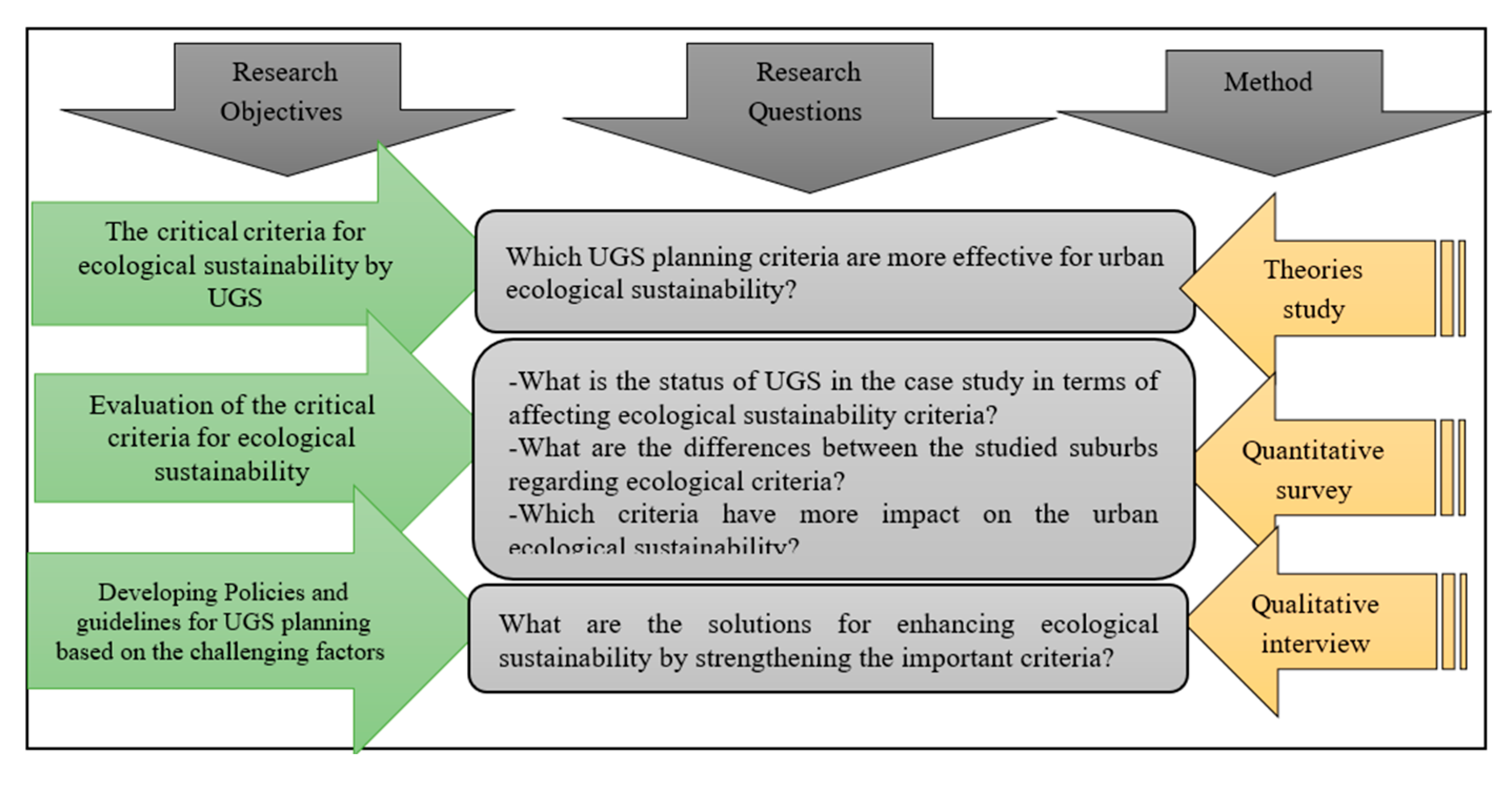
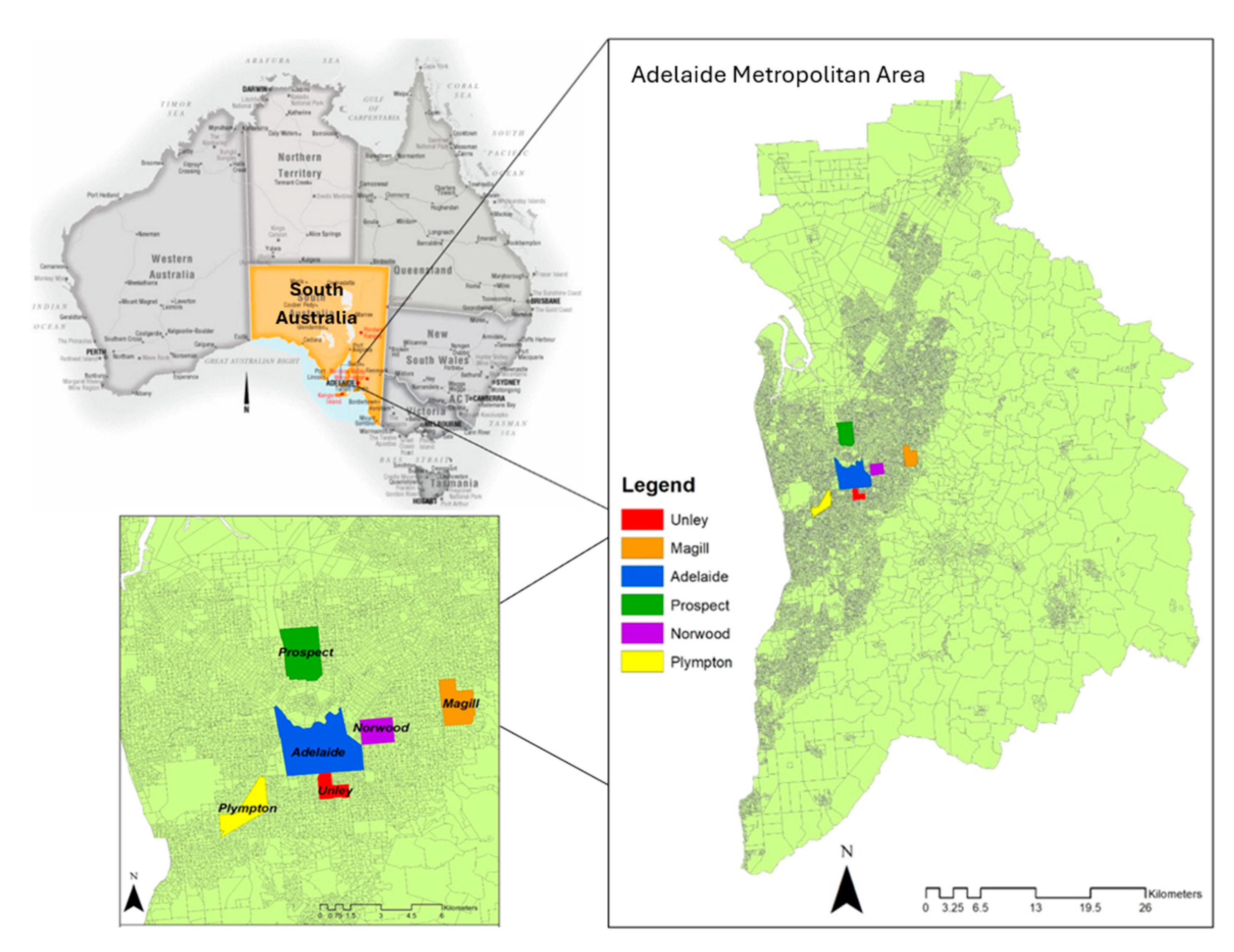
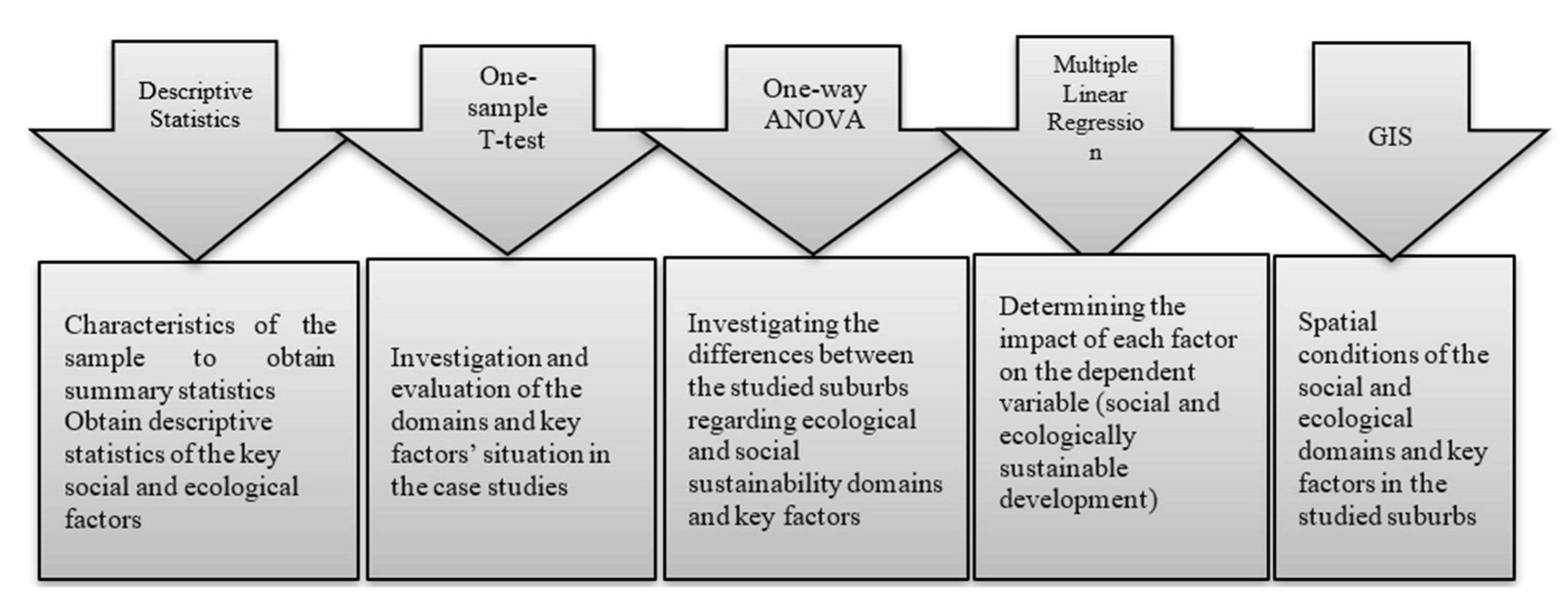
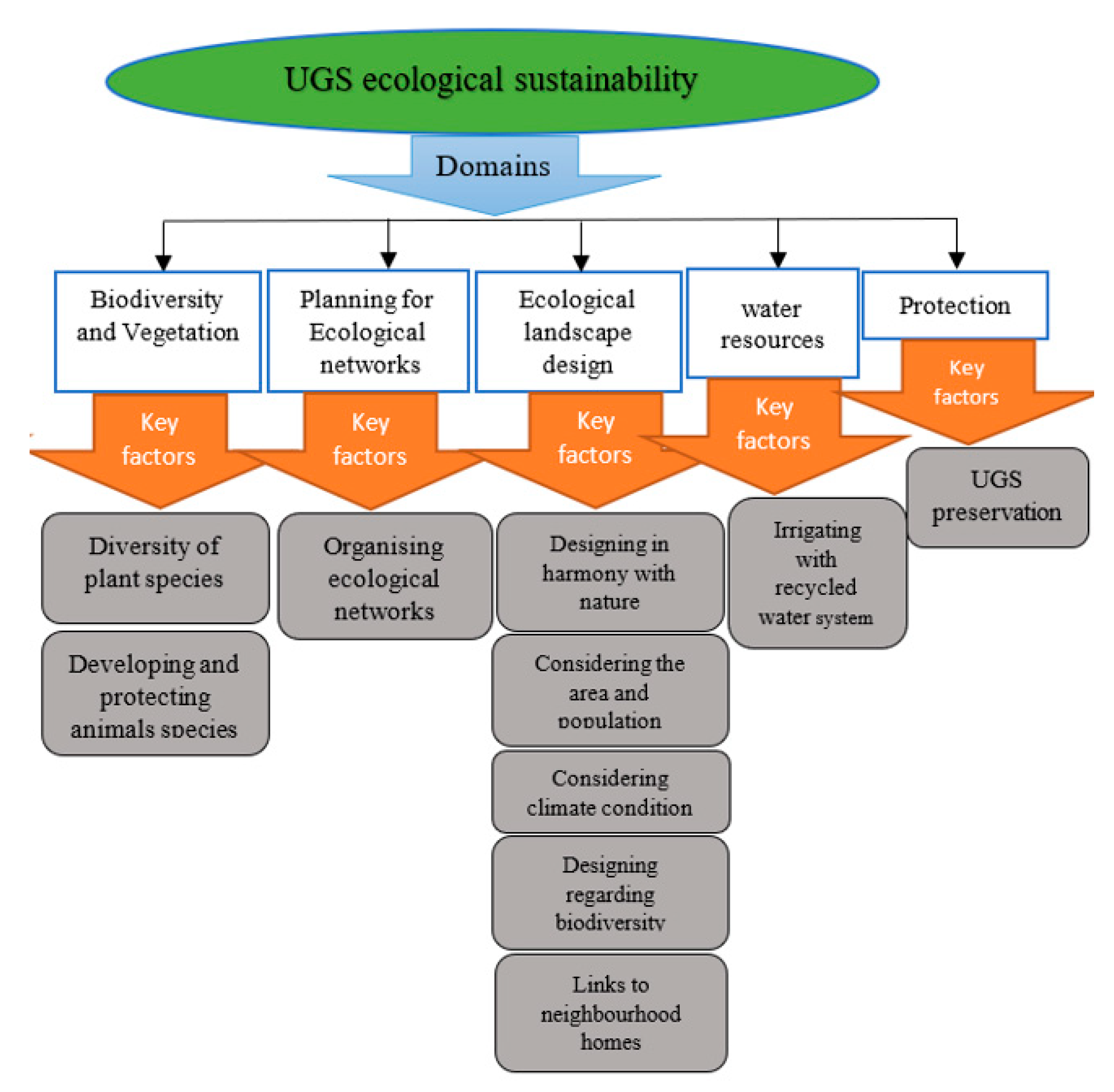

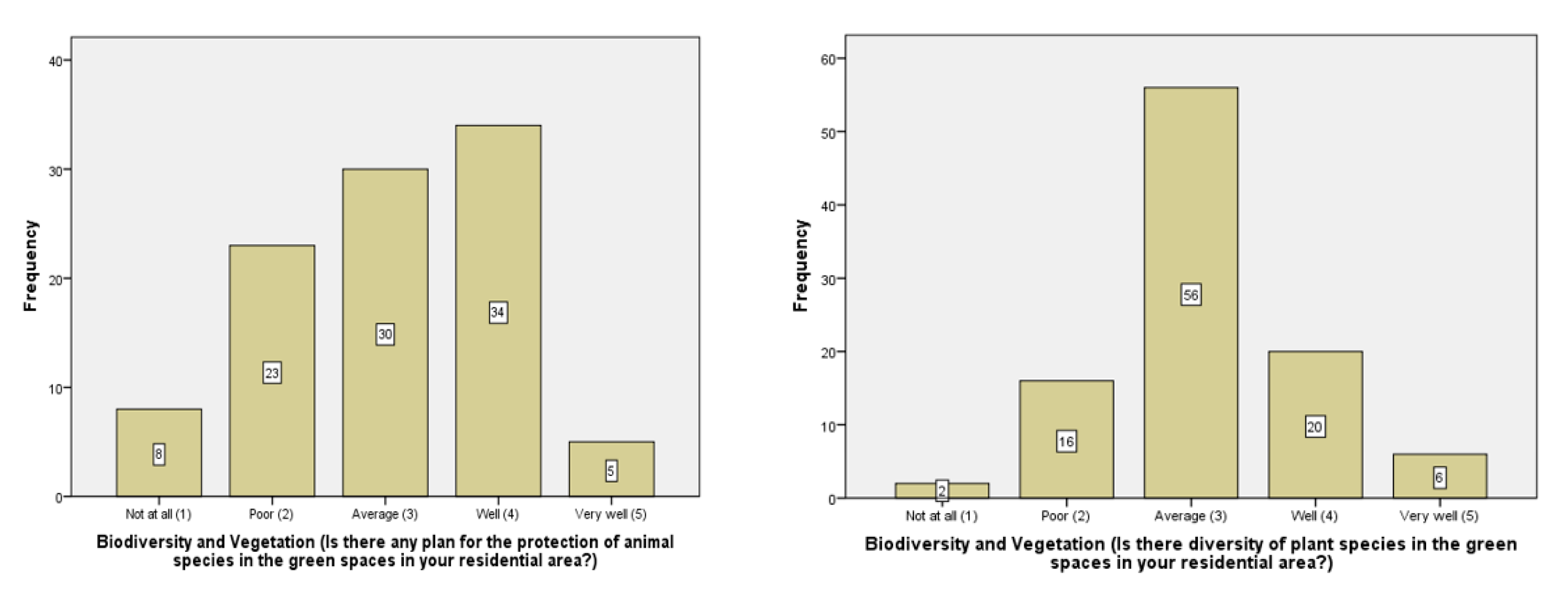

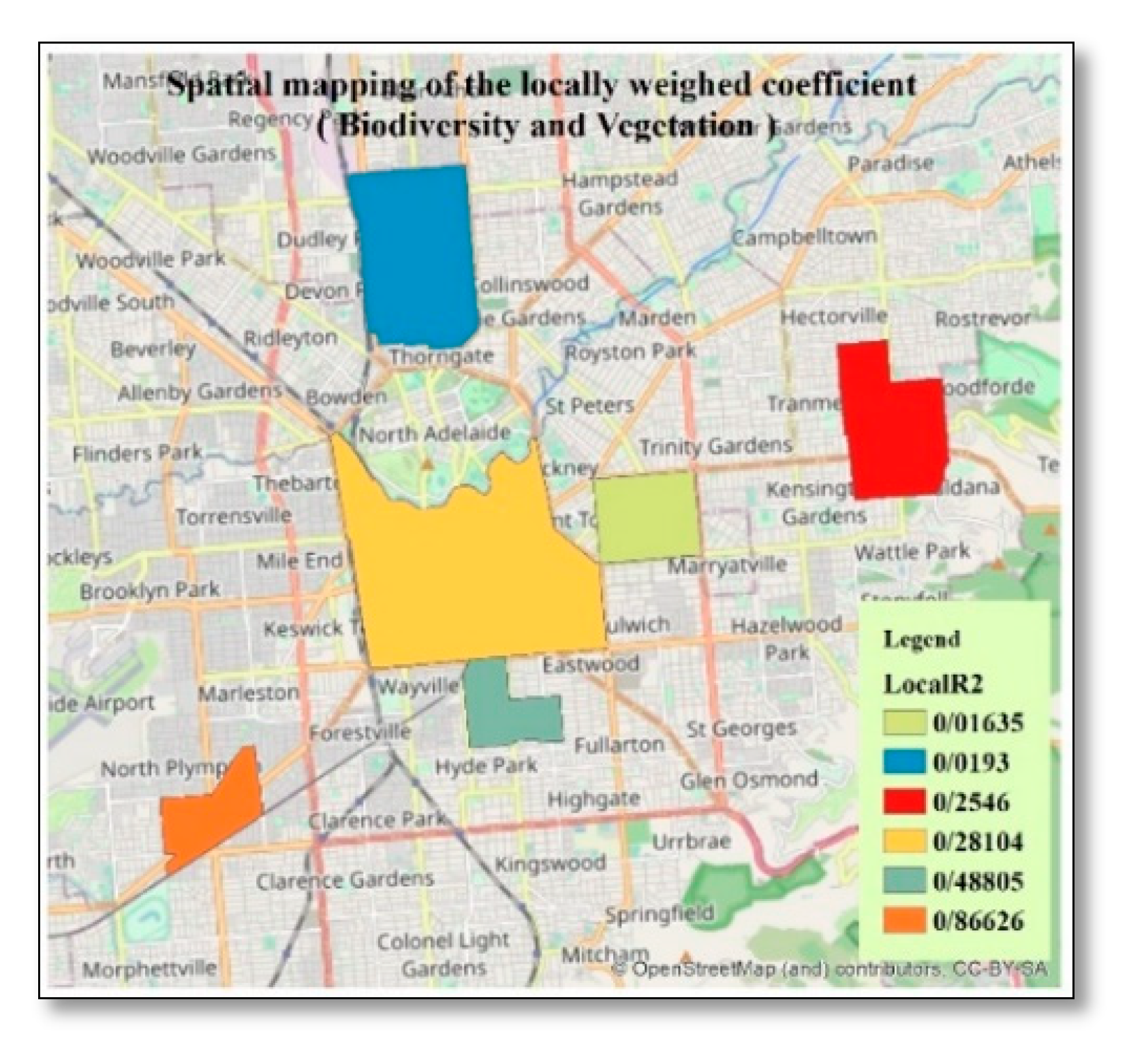
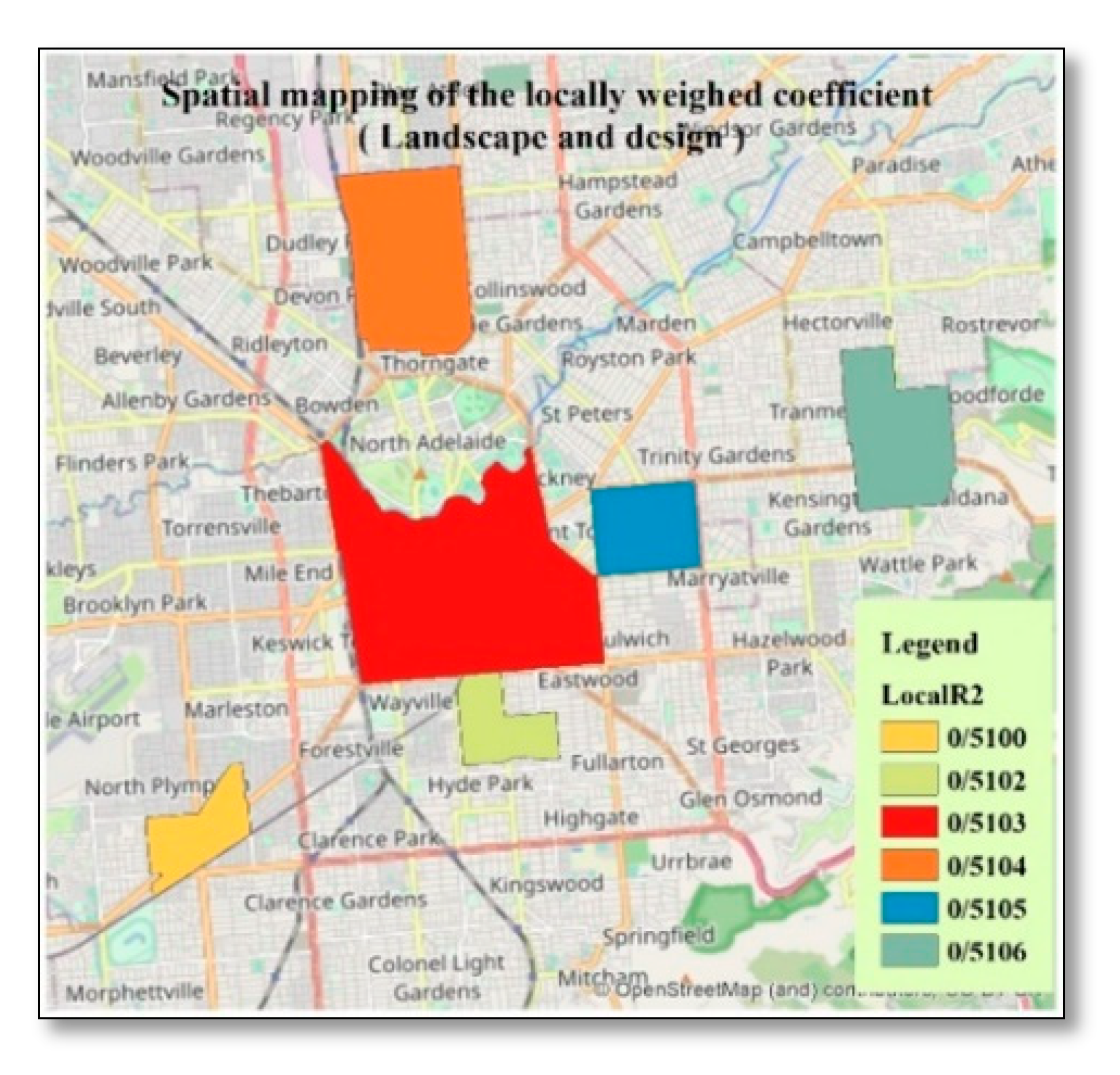
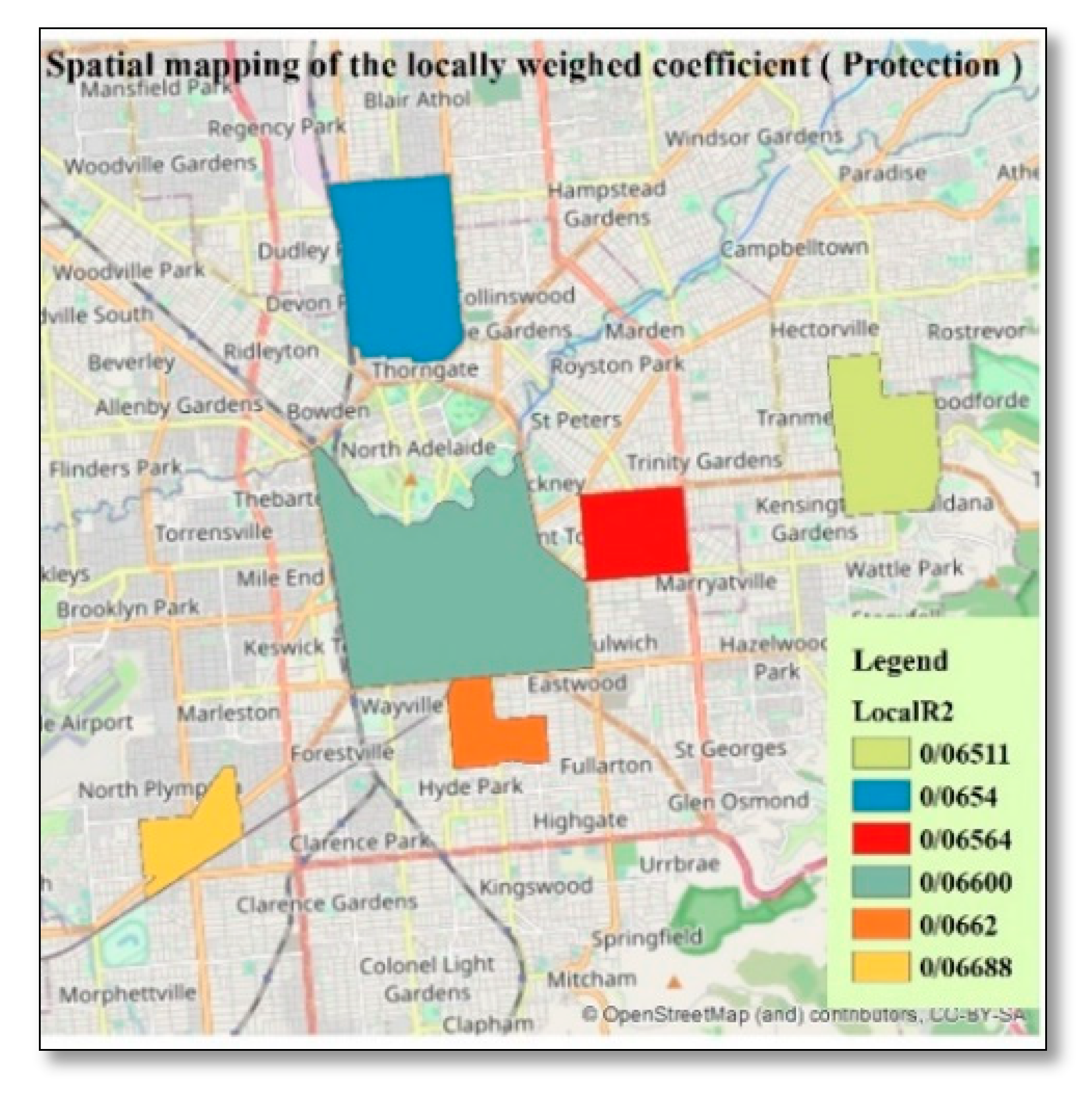
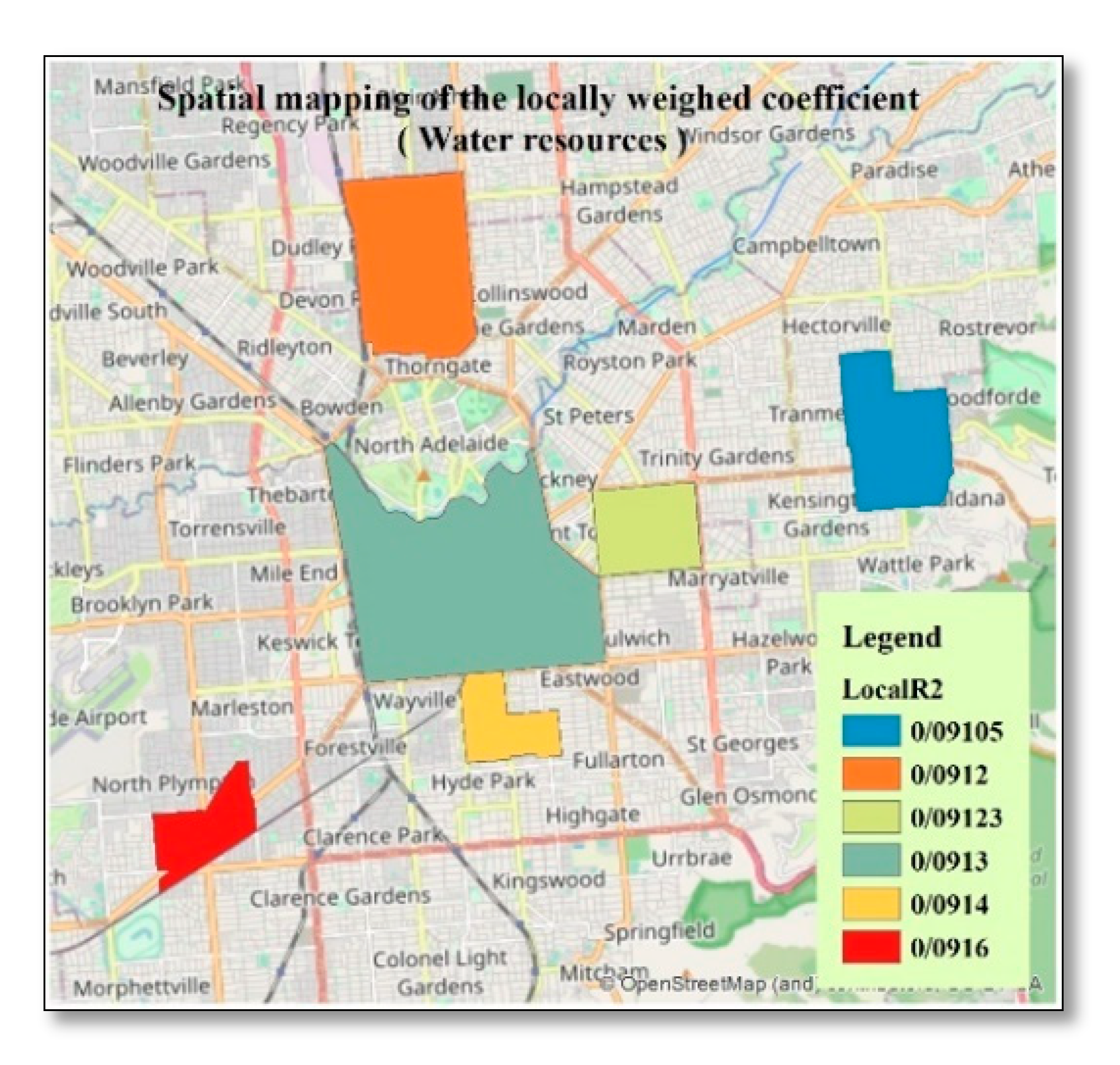
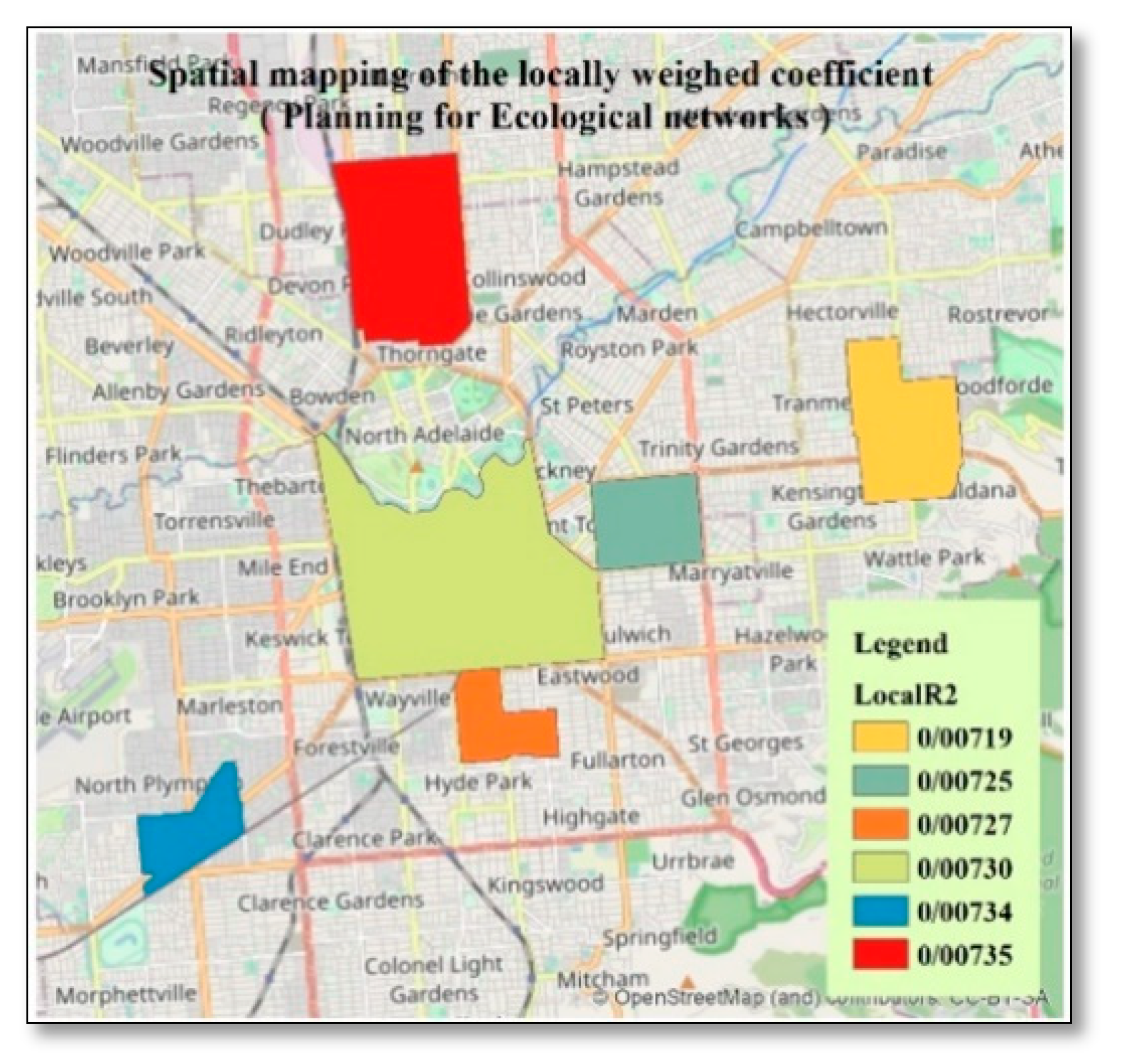
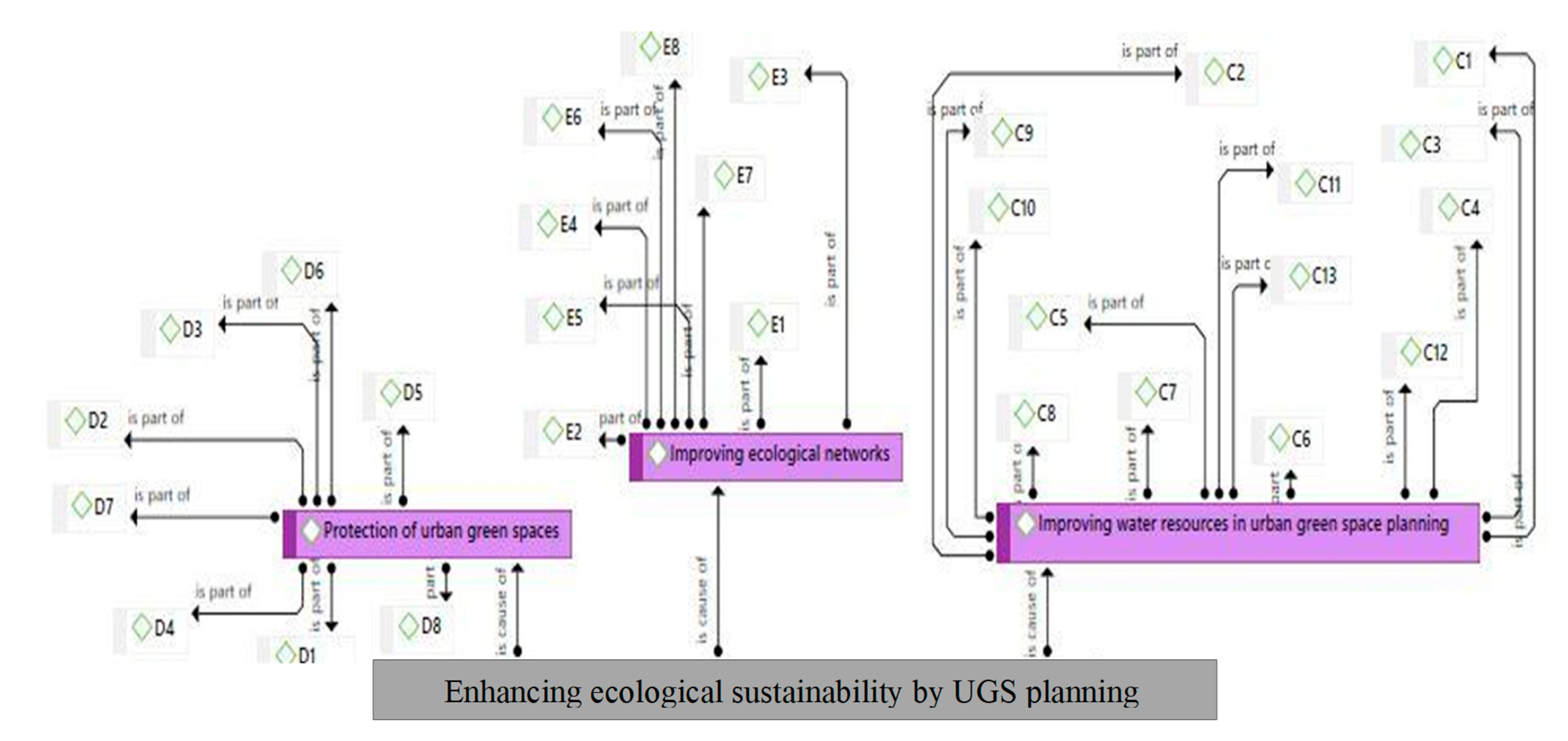
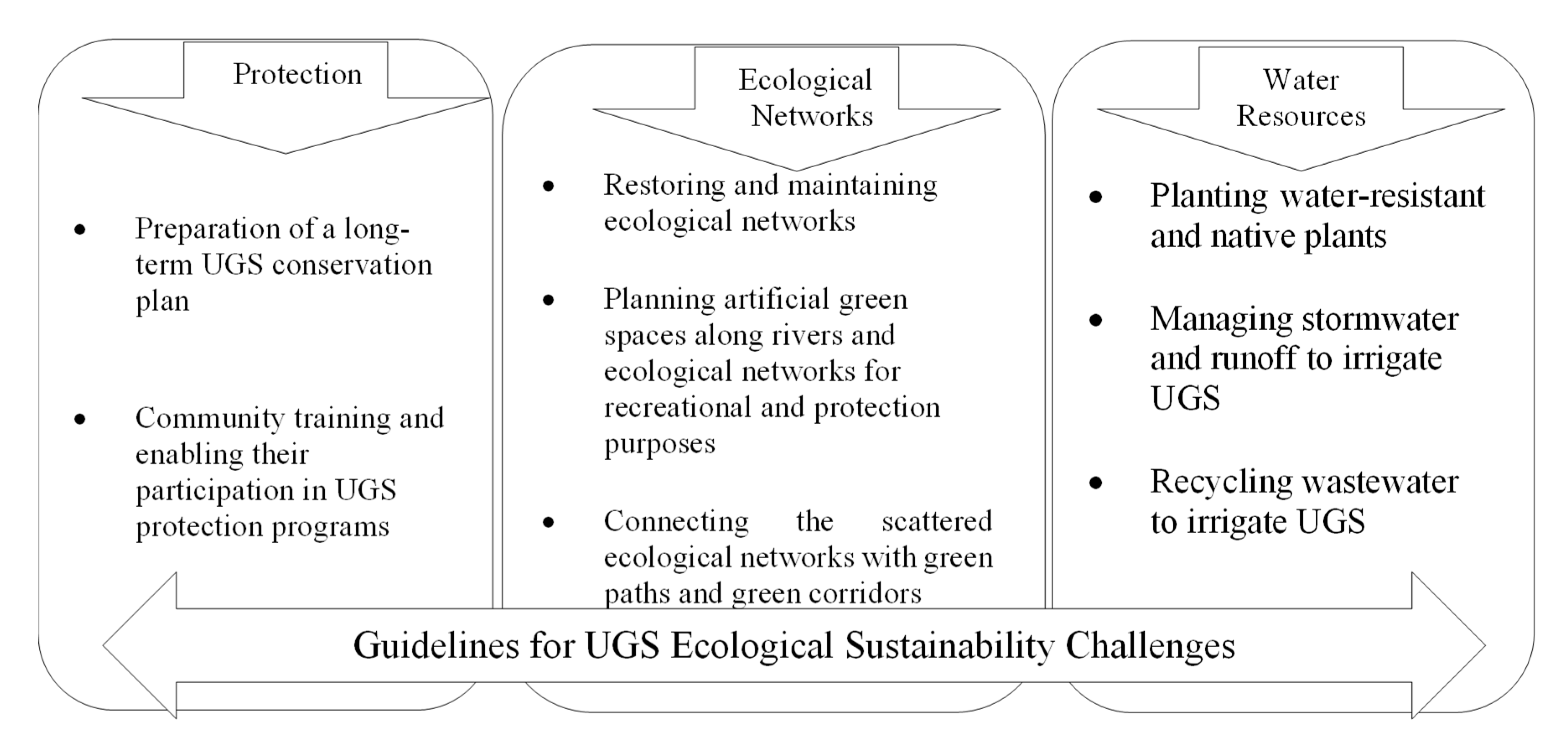
| No | Suburbs | Population | Area (Hectares) | UGS Per Capita (Person per Square Meter) | Share (Percentage) | The Total Area of the Green Spaces in the Metropolitan Area | The Share of the Suburban UGSs from the Total Metro Green Space |
|---|---|---|---|---|---|---|---|
| 1 | Plympton | 4756 | 8.998 | 18.920 | 1.340 | 34,955.8 | 0.026 |
| 2 | Magill | 8861 | 12.287 | 13.866 | 1.830 | 0.035 | |
| 3 | Unley | 4006 | 5.490 | 13.705 | 0.818 | 0.016 | |
| 4 | CBD | 15,115 | 636.914 | 421.379 | 94.871 | 1.822 | |
| 5 | Prospect | 13,280 | 2.128 | 1.602 | 0.317 | 0.006 | |
| 6 | Norwood | 5953 | 5.530 | 9.289 | 0.824 | 0.016 | |
| Total | 51,971 | 671.347 | 129.17 | 100.000 | 1.92 |
| Suburbs | Participants Number | Population | Percent |
|---|---|---|---|
| Adelaide CBD | 20 | 15,115 | 29.084 |
| Norwood | 16 | 5953 | 11.45 |
| Magill | 18 | 8861 | 17.050 |
| Plympton | 15 | 4756 | 9.151 |
| Unley | 13 | 4006 | 7.708 |
| Prospect | 19 | 13,280 | 25.553 |
| Total | 100 | 51,971 | 100 |
| No | Criterion | Cronbach’s Alpha |
|---|---|---|
| 1 | Biodiversity and vegetation | 0.677 |
| 2 | Planning for ecological networks | 0.697 |
| 3 | Landscape and design | 0.735 |
| 4 | Protection | 0.713 |
| 5 | Water resources | 0.689 |
| Ecological Criteria | Ecological Sub-Criteria | References |
|---|---|---|
|
Biodiversity
and vegetation | Planning for developing different species of animals in UGS | [15,27] |
| Considering diversity of plant species | [15,30] | |
| Planting native plants | [30,53] | |
| Emphasizing planting trees instead of other plants | [31] | |
| Dense planting | [54] | |
| Planting productive trees and vegetables | [55] | |
| Planting water-conserving plants | [32,56] | |
| Protection | Biodiversity protection | [57,58] |
| Using recycling facilities in UGS development | [59,60] | |
| Green space preservation programs | [33,61] | |
| Water resources | Irrigation with a rain harvesting system | [35,36] |
| Irrigation with reused recycled water | [37,62] | |
| Wastewater management for UGS irrigation | [37] | |
| Irrigation with retention pond | [63] | |
|
Ecological landscape
design | Designing UGS regarding biodiversity | [15,42] |
| Designing UGS regarding the area and population of the suburbs or neighbourhoods | [40,64] | |
| Designing regarding the natural shape of the land | [65] | |
| Designing regarding climate condition | [41,43] | |
| UGS area | [66,67] | |
| UGS form and shape in harmony with city nature | [46,47] | |
| UGS connectivity | [68] | |
| UGS connections with green corridors | [69,70] | |
| UGS connections with neighbourhood homes | [71] | |
| UGS isolation | [72] | |
| Designing elements and statues in UGS | [73] | |
| Planting colourful flowers | [74] | |
| Designing green pathway-walkway-cycle track | [48,49] | |
| UGS design aesthetic | [44,45] | |
| Considering the structure of UGS (linear, dot, polygon) | [50,51] | |
| Ecological networks | Organizing ecological networks (rivers, marshes, etc.) | [38,75,76] |
| Criteria | No | Domain | No |
|---|---|---|---|
| Is there any plan to protect animal species in the green spaces in your residential area? (F1) | 1 | Biodiversity and vegetation (F) | 1 |
| Is there a diversity of plant species in the green spaces in your residential area? (F2) | 2 | ||
| Are native plants planted in the green spaces in your residential area? (F3) | 3 | ||
| Is there any planning for organising ecological networks (organising rivers, marshes, water bodies, …) (G1) | 4 | Planning for ecological networks (G) | 2 |
| Do the green spaces in your residential area have a form and shape in harmony with nature? (H1) | 5 | Landscape and design (H) | 3 |
| Are the green spaces in your residential area linked with neighbourhood homes? (H2) | 6 | ||
| Should biodiversity be considered in the design of green spaces in your residential area? (H3) | 7 | ||
| Is climate taken care of in the design of green spaces in your residential area? (H4) | 8 | ||
| Is there any preservation program for green spaces in your residential area? (I1) | 9 | Protection (I) | 4 |
| Are the green spaces in your residential area irrigated with recycled water? (J1) | 10 | Water resources (J) | 5 |
| Objects | Not at All (1) | Poor (2) | Average (3) | Well (4) | Very Well (5) | Sum | Average | Overall Average | |
|---|---|---|---|---|---|---|---|---|---|
| F1 | Frequency | 8 | 10 | 30 | 44 | 8 | 100 | 3.34 | 3.31 |
| Percent | 8.15% | 10% | 30% | 44% | 8% | 100% | |||
| F2 | Frequency | 2 | 16 | 46 | 30 | 6 | 100 | 3.22 | |
| Percent | 2% | 16% | 46% | 30% | 6% | 100% | |||
| F3 | Frequency | 4 | 5 | 50 | 32 | 9 | 100 | 3.37 | |
| Percent | 4% | 5% | 50% | 32% | 9% | 100% | |||
| G1 | Frequency | 5 | 17 | 62 | 11 | 5 | 100 | 2.94 | 2.94 |
| Percent | 5% | 17% | 62% | 11% | 5% | 100% | |||
| H1 | Frequency | 1 | 6 | 49 | 27 | 17 | 100 | 3.53 | 3.42 |
| Percent | 1% | 6% | 49% | 27% | 17% | 100% | |||
| H2 | Frequency | 2 | 9 | 50 | 30 | 9 | 100 | 3.35 | |
| Percent | 2% | 9% | 50% | 30% | 9% | 100% | |||
| H3 | Frequency | 4 | 5 | 45 | 26 | 20 | 100 | 3.53 | |
| Percent | 4% | 5% | 45% | 26% | 20% | 100% | |||
| H4 | Frequency | 5 | 9 | 58 | 20 | 8 | 100 | 3.28 | |
| Percent | 5% | 9% | 58% | 20% | 8% | 100% | |||
| I1 | Frequency | 2 | 21 | 52 | 17 | 8 | 100 | 3.08 | 3.08 |
| Percent | 2% | 21% | 52% | 17% | 8% | 100% | |||
| J1 | Frequency | 12 | 14 | 61 | 8 | 5 | 100 | 2.80 | 2.80 |
| Percent | 7% | 4% | 71% | 13% | 5% | 100% | |||
| No | N | df | T | Sig | The Average Limit of the Average | Average | Mean Difference |
|---|---|---|---|---|---|---|---|
| 1 | 382 | 99 | 2.472 | 0.001 | 30 | 31.47 | 1.47 |
| Mode | R | R Square | Adjusted R Square | Std. Error of the Estimate |
|---|---|---|---|---|
| 1 | 0.839 | 0.705 | 0.685 | 5.493 |
| Part | Partial | Zero-Order | Sig | t | Standardized Coefficients Beta | Criterion |
|---|---|---|---|---|---|---|
| 0.299 | 0.533 | 0.563 | 0.000 | 6.178 | 0.323 | Biodiversity and vegetation |
| 0.134 | 0.213 | 0.305 | 0.000 | 2.120 | 0.142 | Planning for ecological networks |
| 0.518 | 0.643 | 0.637 | 0.000 | 8.178 | 0.538 | Landscape and design |
| 0.205 | 0.315 | 0.245 | 0.000 | 3.240 | 0.210 | Water resources |
| 0.300 | 0.437 | 0.548 | 0.000 | 4.738 | 0.331 | Protection |
| Domain (Figure) | Suburbs with Notable Local R2 | Local R2 Range | Key Findings | Relative Influence on Ecological Sustainability |
|---|---|---|---|---|
| Biodiversity and Vegetation (Figure 8) | Plympton (0.866), Unley (0.488) | 0.016–0.866 | Strong positive relationship between biodiversity/vegetation criteria and ecological sustainability, especially in Plympton and Unley. | Most effective domain for promoting ecological sustainability among all studied suburbs. |
| Landscape and Design (Figure 9) | All suburbs (Adelaide CBD, Prospect, Norwood, Unley, Magill, Plympton) | ~0.50–0.51 | Local R2 values are almost identical across suburbs (close to and slightly above 0.5), showing a consistent positive influence. | Moderately strong and uniform effect across all suburbs. |
| Protection (Figure 10) | Prospect (higher values), others lower | 0.065–0.067 | Positive but weaker contribution compared to biodiversity and design. | Relatively low impact. |
| Water Resources (Figure 11) | Prospect, Plympton (slightly higher) | 0.091–0.092 | Very limited effect on ecological sustainability. | Minor effect. |
| Planning for Ecological Networks (Figure 12) | Prospect (higher), Plympton (lower) | 0.071–0.073 | Weakest contribution among all domains. | Lowest impact. |
Disclaimer/Publisher’s Note: The statements, opinions and data contained in all publications are solely those of the individual author(s) and contributor(s) and not of MDPI and/or the editor(s). MDPI and/or the editor(s) disclaim responsibility for any injury to people or property resulting from any ideas, methods, instructions or products referred to in the content. |
© 2025 by the authors. Licensee MDPI, Basel, Switzerland. This article is an open access article distributed under the terms and conditions of the Creative Commons Attribution (CC BY) license (https://creativecommons.org/licenses/by/4.0/).
Share and Cite
Teimouri, R.; Karuppannan, S.; Sivam, A.; Gu, N. Evaluation of Ecological Sustainability Criteria of Urban Green Spaces in Adelaide Metropolitan Area. Urban Sci. 2025, 9, 434. https://doi.org/10.3390/urbansci9100434
Teimouri R, Karuppannan S, Sivam A, Gu N. Evaluation of Ecological Sustainability Criteria of Urban Green Spaces in Adelaide Metropolitan Area. Urban Science. 2025; 9(10):434. https://doi.org/10.3390/urbansci9100434
Chicago/Turabian StyleTeimouri, Raziyeh, Sadasivam Karuppannan, Alpana Sivam, and Ning Gu. 2025. "Evaluation of Ecological Sustainability Criteria of Urban Green Spaces in Adelaide Metropolitan Area" Urban Science 9, no. 10: 434. https://doi.org/10.3390/urbansci9100434
APA StyleTeimouri, R., Karuppannan, S., Sivam, A., & Gu, N. (2025). Evaluation of Ecological Sustainability Criteria of Urban Green Spaces in Adelaide Metropolitan Area. Urban Science, 9(10), 434. https://doi.org/10.3390/urbansci9100434








